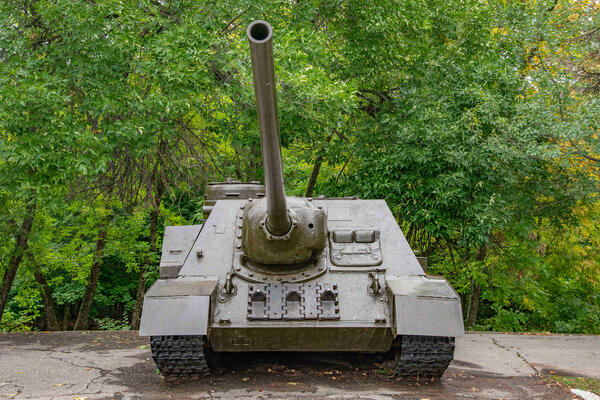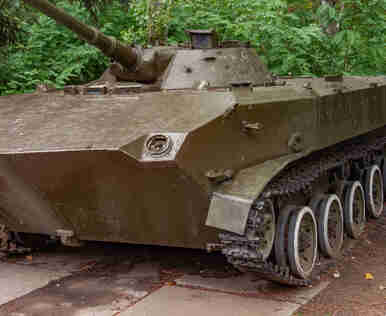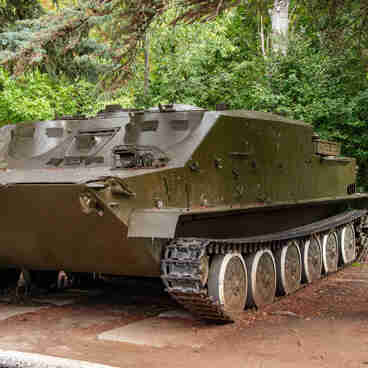The SU-100 self-propelled artillery vehicle was developed in 1943 on the basis of the T-34-85 tank. The project was led by the Soviet designer Lev Izrailevich Gorlitsky. The self-propelled weapon was mass-produced in 1944–1948.
The SU-100 had a classic layout for its time, it was borrowed from the SU-85 self-propelled gun. It belonged to the fully enclosed type of self-propelled weapon systems. The crew of the SU-100 consisted of four people: a driver-mechanic, a commander, a gunner and a loader.
The driver sat in the control compartment in the bow of the hull on the left. The gunner was positioned in the fighting compartment to the left of the gun, and the commander of the vehicle was placed on the right. The loader’s seat was located behind the gunner’s seat.
In comparison to the SU-85, the commander’s workplace was improved in this model. The fighting compartment, which was combined with the control compartment, was located in the front part of the hull, in the fixed casemate superstructure. It housed controls, weapons with sighting devices, ammunition, a radio station with a tank intercom, as well as front fuel tanks and some spare tools and accessories.
The SU-100 was armed with a 100mm D-10S cannon, which had exceptional firepower and was capable of engaging enemy tanks at all ranges of precision fire. The self-propelled gun had a high muzzle velocity when firing armor-piercing rounds, an overall sufficient rate of fire and reliable armor, as well as good cross-country off-road mobility.
These guns could quickly change firing positions, and be prepared for combat or transportation in a matter of minutes. The self-propelled guns could fight on their own, and aided tank and infantry regiments. The thickness of the frontal armor of the self-propelled gun was 75 mm.
When Soviet troops were conducting strategic offensive operations, the SU-100s were often used as assault guns to complete the breakthrough of the enemy’s deep defensive lines, for instance, during the East Prussian offensive of 1945.
After the end of the Second World War, the SU-100 self-propelled artillery units were used by the Soviet Army for several more decades. They were in service with the armies of almost all countries of the Warsaw Pact, as well as Albania, Algeria, Angola, Vietnam, Yemen, North Korea and Cuba.
The SU-100 had a classic layout for its time, it was borrowed from the SU-85 self-propelled gun. It belonged to the fully enclosed type of self-propelled weapon systems. The crew of the SU-100 consisted of four people: a driver-mechanic, a commander, a gunner and a loader.
The driver sat in the control compartment in the bow of the hull on the left. The gunner was positioned in the fighting compartment to the left of the gun, and the commander of the vehicle was placed on the right. The loader’s seat was located behind the gunner’s seat.
In comparison to the SU-85, the commander’s workplace was improved in this model. The fighting compartment, which was combined with the control compartment, was located in the front part of the hull, in the fixed casemate superstructure. It housed controls, weapons with sighting devices, ammunition, a radio station with a tank intercom, as well as front fuel tanks and some spare tools and accessories.
The SU-100 was armed with a 100mm D-10S cannon, which had exceptional firepower and was capable of engaging enemy tanks at all ranges of precision fire. The self-propelled gun had a high muzzle velocity when firing armor-piercing rounds, an overall sufficient rate of fire and reliable armor, as well as good cross-country off-road mobility.
These guns could quickly change firing positions, and be prepared for combat or transportation in a matter of minutes. The self-propelled guns could fight on their own, and aided tank and infantry regiments. The thickness of the frontal armor of the self-propelled gun was 75 mm.
When Soviet troops were conducting strategic offensive operations, the SU-100s were often used as assault guns to complete the breakthrough of the enemy’s deep defensive lines, for instance, during the East Prussian offensive of 1945.
After the end of the Second World War, the SU-100 self-propelled artillery units were used by the Soviet Army for several more decades. They were in service with the armies of almost all countries of the Warsaw Pact, as well as Albania, Algeria, Angola, Vietnam, Yemen, North Korea and Cuba.





